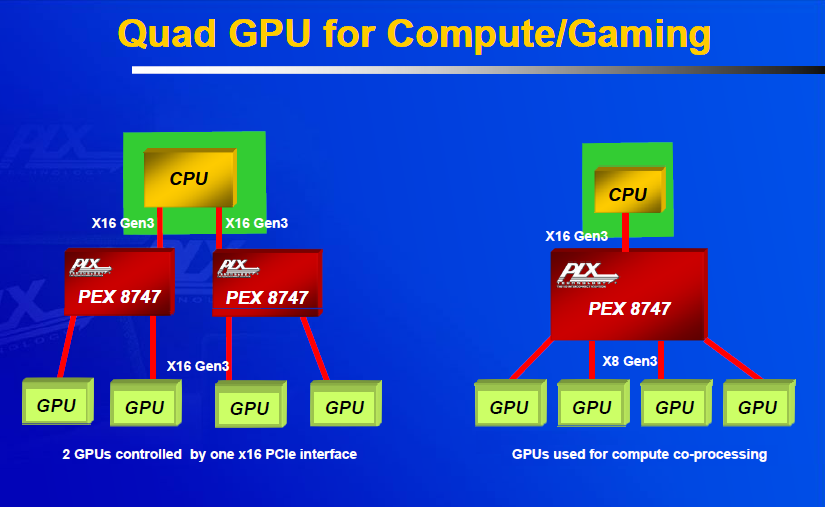PCIe 3.0 is Here; PCIe 4.0 Already in the Works
Tons more bandwidth for future applications.
Last Monday at a morning press conference in Santa Clara, PCI-SIG, the Special Interest Group overseeing the PCI Express standard, officially announced the availability of PCI Express 3.0 products, and stated that work on the PCI Express 4.0 standard has already begun.
PCI-SIG chairman Al Yanes stated that compliance workshops held in April and June included 23 add-in cards and 19 system boards which meet PCI Express 3.0 specifications. Yanes further stated that major products are underway from many PCI-SIG members, including Agilent Technologies, National Semiconductor, PLX Technology, and Tektronix.
The current PCI Express 2.1 standard enables a speed of 500 MB/s per lane, in each direction. Thus, the 16 lane connection commonly used for PCI Express graphics cards currently has a transfer speed of 8 GB/s. The PCI Express 3.0 standard will double the above transfer rates, enabling a speed of 1 GB/s per lane, or 16 GB/s for a 16 lane connection.

Despite the announcement of PCI Express 3.0 products, the biggest news came in the form of two additional announcements: A “Cable Workgroup” has been established to create a new cable standard, possibly with the intention of competing with Intel’s proprietary Thunderbolt technology. Also, early work on the PCI Express 4.0 standard has already begun.
Al Yanes stated that the cabling technology will have a goal of 20 inch cables for use with servers, 14 inch cables for use with desktops, and 10 inch cables for use with mobile devices. The cable is initially expected to push the limits of copper wire technology, but the door is being left open to include optical technology. Yanes stated “We have crossed every bridge we have come to… but we don’t want to rest on our laurels”.
Intel has been non-committal as to whether it will license Thunderbolt to PCI Express add-on card developers. The technology is certainly feasible: a four lane PCI Express 3.0 connection slot, operating at a speed of 4 GB/s (or 32 Gigabits per second), could easily host a 10 Megabit per second Thunderbolt PCI Express add-on card. However, Intel spokesman Dave Salvator told us recently, “There are no plans to do a Thunderbolt expansion card at this time.” This could mean that Intel plans to license Thunderbolt only as a motherboard feature, not as an add-on card feature. It’s certainly feasible that Intel’s plans are what has lead PCI-SIG to decide to develop their own new cabling technology.
As for PCI Express 4.0, PCI-SIG is confident that they’ll be able to once again double transfer speeds when the technology is introduced. Historically, the development of a new PCI Express standard occurs about once every four years, and PCI-SIG stated that the “4 year sequence” would likely continue to be the expected development period.
Get Tom's Hardware's best news and in-depth reviews, straight to your inbox.
PCI Express 3.0 technology is expected to be used to power InfiniBand, Ethernet 40G/100G, ultra high speed Solid State Drives, and, of course, high end graphics cards.
-
zorky9 soma42now just to get a video card that uses all of the PCIe 3.0...... and a CPU to handle all the bandwidth.Reply
I'll wait for Ivy Bridge and mobo/GPU with PCIe 3.0 for my next upgrade. -
claec ReplyIntel has been non-committal as to whether it will license Thunderbolt to PCI Express add-on card developers. The technology is certainly feasible: a four lane PCI Express 3.0 connection slot, operating at a speed of 4 GB/s (or 32 Gigabits per second), could easily host a 10 Megabit per second Thunderbolt PCI Express add-on card.
Is that supposed to be 10 GIGAbits per second for the Thunderbolt? -
warmon6 So is every one happy now that the three 3's are all officially out? :p Usb 3.0, Sata III (6gb/s), and (finally) PCI-e 3.0.Reply -
utengineer warmon6So is every one happy now that the three 3's are all officially out? Usb 3.0, Sata III (6gb/s), and (finally) PCI-e 3.0.Reply
Yes, Rainman is happy now ;) -
RazberyBandit If board makers would flat-out drop 2.0 and fully adopt 2.1, video cards that require 2 x 6-pin (or 1 x 6-pin + 1 x 6+2-pin) would be a thing of the past because the motherboard could actually supply 150W through the PCIe slot itself.Reply
PCIe technology is evolving faster than manufacturers seem willing to adopt it. -
eklipz330 NetherscourgeHas PCI-e 2.0 been maxed out yet, in everyday desktop application?nope? lollReply